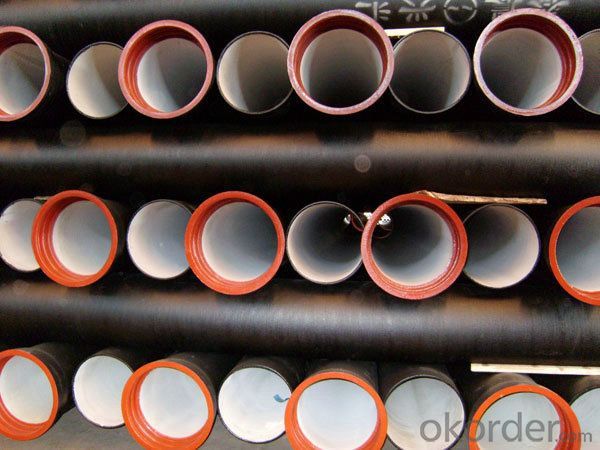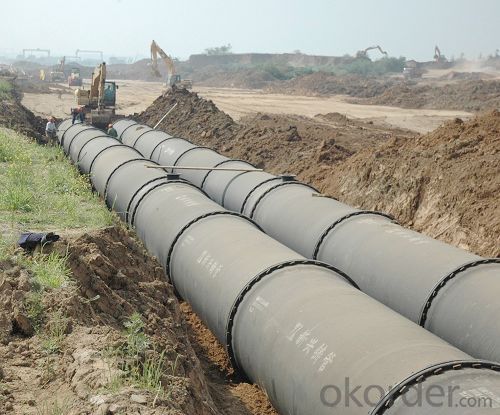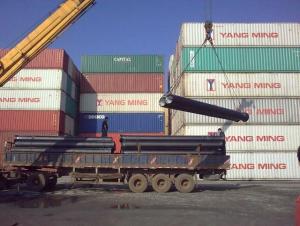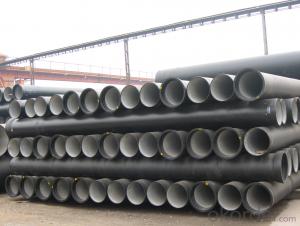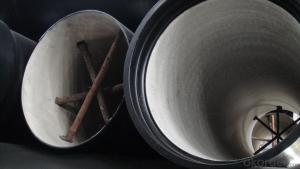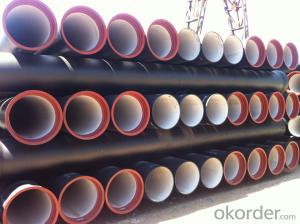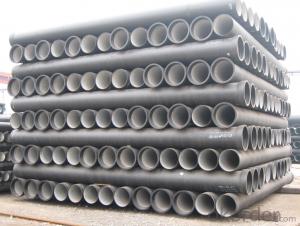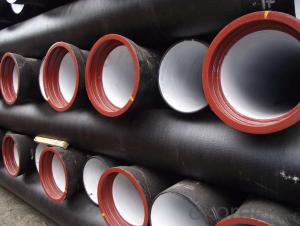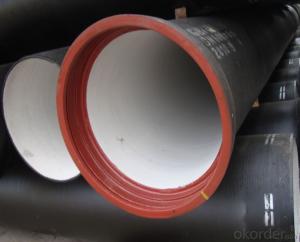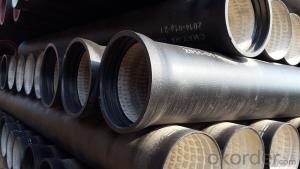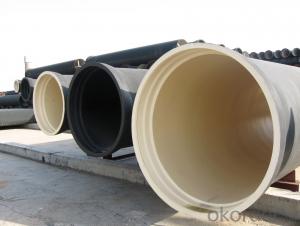Ductile Iron Self Restrained Pipe of China DN300 for Water Supply
- Loading Port:
- China main port
- Payment Terms:
- TT or LC
- Min Order Qty:
- 20 m.t.
- Supply Capability:
- 100000 m.t./month
OKorder Service Pledge
OKorder Financial Service
You Might Also Like
1,Ductile Iron Self Restrained Pipe Description :
The ductile iron self restrained pipe manufactured by SYI foundry are mainly used for conveying many fluid media such as water, oil and gas, are widely used in various pipeline projects for metallurgy, mine, water conservancy, petroleum and urban public service utility. Self-restrained joint adopts the T type joint sealing structure. Compared with T-type joint, adds a welded bead on spigot, and open-end locking ring, a gland and connecting bolts to provide the joint with good anti-slippage performance. The locking ring and the gland can slide between each other, so that the joint had certain axial stretching and deflection capability.
2,Main Features of the Ductile Iron Self Restrained Pipe:
The diameter is from DN 80 to DN 2000(Tyton, Class K7/9/14) under standard ISO2531 4179 8179 EN545, normally work length is 6 meters, Tyton socket-spigot, K9.
The ductile cast iron pipe, cast pipe & cast iron pipe manufactured by SYI is mainly used for conveying fluid media.
3,Ductile Iron Self Restrained Pipe Images:
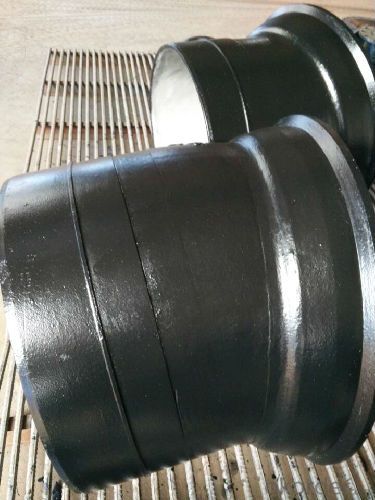

4. Ductile Iron Self Restrained Pipe Specification
1. Material: Ductile iron grade 500-7/ 450-10 in accordance with ISO1083
2. Standard: ISO 2531, EN545, EN598, ANSI, AWWA
3. Certificate: ISO9001, ISO14001, SGS, NSF, WRAS
4. Test: In accordance with ISO 2531 / EN 545 / EN598 and 100% water pressure test
5. Length: 6m or cut into 5.6m, 5.7m, 5.8m
6. Internal Lining: Cement, conform to ISO4179
7. External coating: Zinc + Bitumen, conform to ISO8179
8. Rubber: NBR, SBR, EPDM according to ISO4633 / EN681.1
9. Note: The gaskets, bolts & nuts are supplied respectively as your special requirement
5.FAQ:
We have organized several common questions for our clients,may help you sincerely:
1.Q: Why would you choose ductile iron pipe rather than other pipe materials?
A:The reasons are obvious for that not only ductile iron pipe possesses the inherent strength and flexibility of ductile iron, combined with proven corrosion protection systems, but also the cost savings can be achieved from design to installation and commissioning.
2.Q:Why can you guarantee the inner of pipes can’t be corroded?
A: High alumina cement mortar lining and sulphate-resistant cement mortar lining. These two special linings are applicable to inner anti-corrosion for sewage pipes, improving resistance to erosion of the sewage components.
- Q: Can ductile iron pipe be used for sewer and wastewater systems?
- Indeed, sewer and wastewater systems can make use of ductile iron pipe. Ductile iron, a variant of cast iron, boasts enhanced attributes such as heightened durability, strength, and flexibility. These characteristics render it apt for subterranean usage, encompassing sewer and wastewater systems. Ductile iron pipes possess resistance against corrosion and are capable of enduring high-pressure circumstances, rendering them perfect for the conveyance of sewage and wastewater. Furthermore, ductile iron pipes boast an extended lifespan and necessitate minimal upkeep, thereby making them a financially prudent alternative for sewer and wastewater infrastructure.
- Q: Are ductile iron pipes suitable for installation in areas with high soil compaction and traffic loads?
- Yes, ductile iron pipes are suitable for installation in areas with high soil compaction and traffic loads. Ductile iron pipes have high strength and durability, making them capable of withstanding heavy loads and compression from soil compaction. They offer excellent resistance to external forces and have a long lifespan, making them a reliable choice for such conditions.
- Q: What are the typical joint restraint requirements for ductile iron pipes?
- The typical joint restraint requirements for ductile iron pipes include the use of mechanical joint restraints or push-on joint restraints. These restraints are necessary to prevent the pipe from separating or pulling apart under various operating conditions, such as internal pressure, external loads, and ground movement. Mechanical joint restraints are commonly used in applications where the pipe is subjected to high internal pressures or external loads. They typically consist of a gland and a follower gland, which are tightened around the pipe joint using bolts or clamps. This helps to secure the joint and prevent any movement or separation. Push-on joint restraints, on the other hand, are used in applications where the pipe is not subjected to high internal pressures or external loads. These restraints are designed to provide a seal and prevent the pipe from pulling apart due to ground movement or other external forces. They are installed by pushing the pipe into the joint and securing it with a restraining ring or collar. In addition to these joint restraints, it is also important to consider the bedding and backfill requirements for ductile iron pipes. Properly compacted and supportive bedding and backfill materials help to distribute the loads and provide stability to the pipe system, further enhancing its resistance to joint separation. It is worth noting that the specific joint restraint requirements for ductile iron pipes may vary depending on the project specifications, pipe size, and operating conditions. Therefore, it is important to consult the manufacturer's recommendations and engineering standards to ensure the proper selection and installation of joint restraints for ductile iron pipes.
- Q: What are the different methods for repairing ductile iron pipe?
- There are several methods available for repairing ductile iron pipes, depending on the extent and location of the damage. One common method is the use of repair clamps or couplings. These are designed to provide a temporary or permanent solution for leaks or cracks in the pipe. Repair clamps are typically made of stainless steel and are fitted around the damaged area, sealing it off and preventing further leakage. Another method is the use of epoxy lining or patching. This involves applying a specialized epoxy material to the inside of the pipe, which forms a protective barrier over the damaged area. This method is often used for smaller cracks or leaks and can provide a long-lasting solution. For more extensive damage, such as large cracks or fractures, the damaged section of the pipe may need to be cut out and replaced. This process typically involves excavating the area around the damaged pipe, removing the damaged section, and installing a new piece of ductile iron pipe. In some cases, trenchless repair methods may be used. This involves using advanced techniques such as pipe bursting or cured-in-place pipe lining to repair the pipe without the need for extensive excavation. These methods can be more cost-effective and less disruptive compared to traditional repair methods. It is important to note that the specific method chosen for repairing ductile iron pipes will depend on factors such as the extent of the damage, the location of the pipe, and the available resources and expertise. Consulting with a professional pipe repair service is recommended to determine the most suitable method for a specific repair situation.
- Q: What are the different lining thickness options for ductile iron pipe?
- The different lining thickness options for ductile iron pipe typically range from 3 to 5 millimeters.
- Q: How are ductile iron pipes different from PVC pipes?
- Ductile iron pipes and PVC pipes are utilized extensively in plumbing and water distribution systems, but they differ significantly in terms of their composition and properties. Ductile iron pipes are crafted from a particular form of cast iron that contains graphite nodules, which provide the material with ductility and flexibility. Consequently, these pipes can endure high pressures and heavy loads without succumbing to breakage or cracking. Ductile iron pipes are renowned for their robustness and longevity, making them particularly suitable for underground applications and areas with substantial traffic. Conversely, PVC pipes are constructed from a plastic known as polyvinyl chloride. These pipes possess rigidity and lack the same level of strength as ductile iron pipes. PVC pipes are commonly employed in low-pressure scenarios, such as residential plumbing systems, irrigation, and drainage systems. These pipes are lightweight, easy to install, and resistant to corrosion, rendering them a favored option for residential and non-industrial purposes. The cost disparity between ductile iron pipes and PVC pipes represents another distinction. Due to higher material and production expenses, ductile iron pipes tend to be pricier. Conversely, PVC pipes are relatively inexpensive to manufacture, making them a cost-effective choice for numerous plumbing projects. In summary, the primary disparities between ductile iron pipes and PVC pipes involve their composition, strength, flexibility, and cost. Ductile iron pipes, formed from cast iron, are celebrated for their strength and durability, while PVC pipes, formed from plastic, are lighter and more cost-effective. The selection between these two types of pipes depends on the specific demands of the plumbing project, including pressure, load-bearing capacity, and budgetary considerations.
- Q: Comparison of ductile iron pipe and spiral steel pipe
- Can only be used for drainage pipe for comparison, other uses are not mentioned in the same breath.
- Q: Can ductile iron pipes be used for underground sewage systems?
- Yes, ductile iron pipes can be used for underground sewage systems. Ductile iron is a strong and durable material that is resistant to corrosion and can handle the high pressure and constant flow of sewage. Additionally, ductile iron pipes have a long lifespan and require minimal maintenance, making them suitable for underground sewage systems.
- Q: How are ductile iron pipes inspected for quality control?
- Ductile iron pipes are inspected for quality control through a series of rigorous tests and inspections to ensure their compliance with industry standards. One of the most common methods used is visual inspection, where trained inspectors examine the pipes for any visible defects such as cracks, pits, or surface irregularities. This helps in identifying any visual defects that may compromise the overall quality of the pipes. In addition to visual inspection, another crucial quality control measure is dimensional inspection. This involves measuring the dimensions of the pipes, such as diameter, wall thickness, and length, using specialized tools and equipment. By comparing these measurements against the specified tolerances, any deviations can be identified, and necessary corrective actions can be taken. Another important quality control step is hydrostatic pressure testing. In this test, the pipes are subjected to internal pressure that is higher than their intended operating pressure. This ensures that the pipes can withstand the required pressure without any leakage or failure. The test involves filling the pipes with water and gradually increasing the pressure, while closely monitoring for any signs of leakage or deformation. Furthermore, ductile iron pipes undergo various mechanical tests, such as tensile strength testing and impact testing, to evaluate their mechanical properties. These tests involve applying controlled forces or impacts to the pipes and measuring their response. By doing so, the strength, toughness, and durability of the pipes can be assessed, ensuring they meet the necessary requirements. Lastly, metallurgical examinations are conducted to analyze the microstructure of the ductile iron pipes. This involves taking samples from the pipes and using microscopy techniques to examine the grain structure, phase distribution, and any potential defects at a microscopic level. This helps in identifying any issues that may not be visible to the naked eye but could affect the overall quality of the pipes. Overall, the inspection process for ductile iron pipes involves a combination of visual, dimensional, hydrostatic, mechanical, and metallurgical tests. These quality control measures help ensure that the pipes meet the required standards, providing reliable and durable infrastructure for various applications.
- Q: Can ductile iron pipe be used for stormwater management systems?
- Yes, ductile iron pipe can be used for stormwater management systems. Ductile iron pipe is commonly used in various applications, including stormwater drainage systems. It is known for its strength, durability, and resistance to corrosion, making it ideal for withstanding the harsh conditions of stormwater management. Additionally, ductile iron pipe is easily installed and maintained, making it a cost-effective choice for stormwater management systems. Overall, ductile iron pipe is a reliable and suitable option for constructing stormwater management systems.
Send your message to us
Ductile Iron Self Restrained Pipe of China DN300 for Water Supply
- Loading Port:
- China main port
- Payment Terms:
- TT or LC
- Min Order Qty:
- 20 m.t.
- Supply Capability:
- 100000 m.t./month
OKorder Service Pledge
OKorder Financial Service
Similar products
Hot products
Hot Searches
Related keywords


